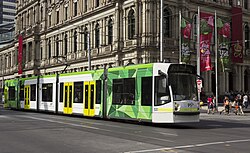D class Melbourne tram
| D-class | |
|---|---|

|
|
| Manufacturer | Siemens |
| Assembly | Uerdingen |
| Constructed | 2002-2004 |
| Number in service | 59 |
| Fleet numbers | D1 3501–D1 3538 D2 5001–D2 5021 |
| Capacity | D1/D2: 32/56 (Seated) D1/D2: 90/130 (Standing) |
| Depot(s) |
Brunswick Malvern Southbank |
| Specifications | |
| Train length | D1: 20.04 m (65 ft 9 in) D2: 29.85 m (97 ft 11 in) |
| Width | 2.65 m (8 ft 8 in) |
| Height | D1: 3.65 m (12 ft 0 in) D2: 3.53 m (11 ft 7 in) |
| Doors | D1: 6 D2: 8 |
| Articulated sections | D1: 2 D2: 4 |
| Wheelbase | 1.8 m (5 ft 11 in) |
| Weight | D1: 25.8 t (25.4 long tons; 28.4 short tons) D2: 35.3 t (34.7 long tons; 38.9 short tons) |
| Traction motors | 4 x 100 kW (130 hp) |
| Electric system(s) | 600 V DC catenary |
| Current collection method | Pantograph |
| Track gauge | 1,435 mm (4 ft 8 1⁄2 in) standard gauge |
The D-class trams are low-floor Combino trams that operate on the Melbourne tram network. They were built by Siemens in Uerdingen, Germany, and are divided into two classes: the three section D1-class which was introduced between 2002 and 2004, and the five section D2-class which was introduced in 2004. The D-class was procured by M>Tram and have been operated by Yarra Trams since they took control of the entire tram network in December 2002.
To meet a franchise commitment to introduce new trams to replace Z-class trams, 59 German built Siemens, Combino low-floor trams were introduced by M>Tram.
The first tram arrived for testing in August 2002, and the first four entered service in November 2002. M>Tram operations were transferred to Yarra Trams in April 2004 following negotiations with the State Government after National Express handed the M>Tram franchise back to the government in December 2002.
To aid disabled access to trams from platform stops 'gap eliminators' were fitted to all 59 D-class trams in 2013. Costing $400,000 to fit to the fleet, they are a strip attached to the door step of the trams that prevent the wheels of wheelchairs from getting stuck between the door step and platform. 'Gap eliminators' proved successful in an earlier 2012 trial on two route 96 Ds, before being fitted to all D-class trams. In August 2004, D1 3507 was badly damaged in a collision and returned to Germany in November 2004 for repairs. It did not return to service until March 2009.
In early 2013 all 59 D-class trams had their passenger information systems upgraded to announce upcoming stops. The upgrade, which cost $343,000, allows announcements on all routes on which D-class trams regularly travel and their alternative deviations, informing passengers of upcoming stops and connections.
...
Wikipedia
